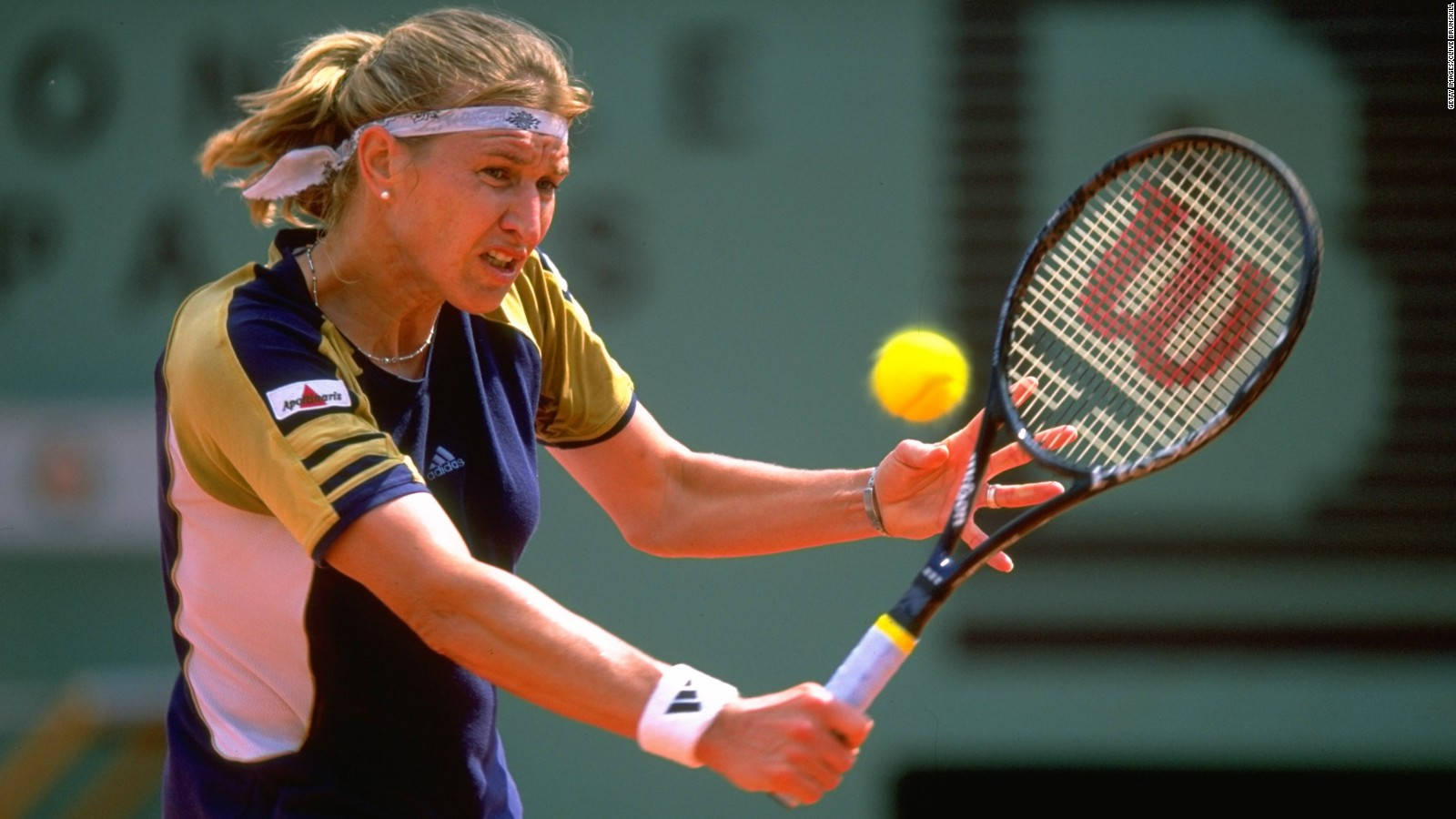In the annals of tennis history, where legends are forged through Grand Slam triumphs and sustained excellence, few names resonate with the same blend of awe and admiration as Steffi Graf. Her game, built on a thunderous forehand, lightning-fast footwork, and an unshakeable mental fortitude, propelled her to a level of dominance that redefined women’s tennis.1 From a prodigious German teenager to the undisputed queen of the court, her journey is a testament to relentless dedication, an insatiable competitive drive, and a quiet grace that belied her ferocious power on the court. This is the story of a player who achieved the unattainable, shattered records, and left an indelible mark that continues to inspire generations.
Early Life and the German Machine (Pre-1987) :
Born on June 14, 1969, in Mannheim, West Germany, Stefanie Maria Graf was introduced to tennis at an exceptionally young age by her father, Peter Graf, an insurance salesman and aspiring tennis coach.2 Peter recognized his daughter’s extraordinary talent almost immediately and became the driving force behind her early development.3 He famously set up a mini-court in their living room, using a bedsheet as a net, and offered her ice cream if she could hit 25 consecutive forehands. This early, almost obsessive, focus on the forehand would become the cornerstone of her game.
Under her father’s meticulous tutelage, Steffi developed a highly disciplined and rigorous training regimen. She quickly dominated junior competitions in Germany, showcasing a powerful forehand, a consistent backhand slice, and exceptional athleticism. Her progression through the ranks was rapid. She turned professional at just 13 years old in 1982, a testament to her precocious talent.
Her early years on the professional tour were a steady ascent. She gained valuable experience competing against seasoned veterans, refining her all-court game, and building the physical and mental stamina required for the demands of elite tennis. She famously captured the attention of the tennis world by reaching the fourth round of the US Open in 1986, where she pushed Martina Navratilova, then the undisputed world No. 1, to three sets. This performance signaled her arrival and hinted at the extraordinary rivalry that would define the sport in the coming years.
The Rise to Dominance: Rivalry and the Golden Slam (1987-1988)
The year 1987 marked Steffi Graf’s true breakthrough into the sport’s elite. She captured her first Grand Slam title at the French Open, defeating Navratilova in a thrilling final. This victory ended Navratilova’s remarkable run of six consecutive Grand Slam singles finals and announced Graf as a formidable force, ready to challenge the established order.4 She also reached the Wimbledon final that year, losing to Navratilova, setting the stage for an intense rivalry.5 By the end of 1987, Graf had ascended to the World No. 1 ranking, ending Navratilova’s record 156-week reign.
However, it was the year 1988 that would forever etch Steffi Graf’s name into the annals of sporting immortality. In an unprecedented display of dominance, she achieved what no other tennis player, male or female, has ever done: the Golden Slam.
- Australian Open: She defeated Chris Evert in the final, dropping only two games.
- French Open: She defended her title, once again defeating a formidable opponent.
- Wimbledon: She famously defeated Martina Navratilova in the final, securing her first Wimbledon title.
- US Open: She completed the Grand Slam by defeating Gabriela Sabatini in the final.
- Olympic Gold: To cap off her extraordinary year, just weeks after winning the US Open, Graf traveled to Seoul, South Korea, and won the Olympic gold medal in singles, defeating Gabriela Sabatini again in the final.6
The “Golden Slam” was an astonishing feat, a perfect calendar Grand Slam combined with an Olympic gold medal, highlighting her unparalleled dominance across all surfaces and in every major competition.7 It showcased her extraordinary fitness, mental fortitude, and a game that was simply superior to her rivals.
Unprecedented Reign and Consumed by Greatness (1989-1996) :
Following her Golden Slam year, Steffi Graf continued her remarkable reign at the top of women’s tennis. She won multiple Grand Slam titles year after year, demonstrating incredible consistency and an insatiable hunger for victory.8
- Sustained No. 1 Ranking: She held the World No. 1 ranking for a record 186 consecutive weeks (tying Serena Williams for the longest streak in Open Era history for either gender) and a total of 377 weeks (the most by any player, male or female, in the Open Era).
- Multiple Grand Slams Across All Surfaces: Graf was truly an all-surface player, winning multiple titles at each of the four Grand Slams:9
- Australian Open: 4 titles
- French Open: 6 titles
- Wimbledon: 7 titles
- US Open: 5 titles
- Rivalries and Adaptability: While Navratilova was her early rival, Graf also faced and dominated a new generation of players, including Monica Seles, Gabriela Sabatini, Arantxa Sánchez Vicario, and Martina Hingis. She adapted her game to counter their strengths, showcasing her tactical intelligence and versatility.10
However, this period of immense success was also marked by significant personal and external challenges. The intense pressure, the demands of constant travel, and unfortunately, the highly publicized legal and tax issues involving her father, cast a long shadow over her career. The brutal stabbing of Monica Seles in 1993, which robbed tennis of a captivating rivalry and a powerful force, also deeply affected Graf. Despite these immense distractions, she continued to perform at an elite level, a testament to her incredible mental resilience and focus. She won four consecutive Australian Open, French Open, and Wimbledon titles between 1993 and 1994, a staggering achievement.
Battling Adversity and a Fairytale Farewell (1997-1999) :
As the late 1990s approached, Steffi Graf began to battle persistent injuries, particularly issues with her knees and back. These physical ailments, combined with the emotional toll of her father’s legal troubles and the relentless grind of professional tennis, began to take their toll. Her dominance, while still present in flashes, was no longer as absolute as it had been.
Despite these challenges, Graf continued to compete at the highest level, demonstrating her unwavering competitive spirit.11 Her most famous comeback came at the 1999 French Open. Battling injuries and facing a younger, dominant Martina Hingis in the final, Graf rolled back the years with a vintage performance, ultimately winning her sixth French Open title, a truly emotional victory that surprised many. This win marked her 22nd Grand Slam singles title, placing her second on the all-time Open Era list behind Margaret Court.
Just weeks later, she reached the Wimbledon final, losing a hard-fought match to Lindsay Davenport. Shortly after, in August 1999, at the age of 30, Steffi Graf announced her retirement from professional tennis. She retired as the reigning French Open champion and still ranked among the top players in the world, choosing to leave the sport on her own terms, at a time when she felt she could no longer give 100% physically and mentally.
The Graf Game: A Blend of Power, Precision, and Poise
Steffi Graf’s playing style was characterized by its unique combination of power and precision, executed with an almost mechanical efficiency:
- The Forehand: Her signature weapon. Graf possessed one of the greatest forehands in tennis history, hit with immense power and heavy topspin.12 She could dictate rallies from anywhere on the court, hitting winners down the line or cross-court with devastating accuracy.
- Backhand Slice: While her forehand was her hammer, her backhand slice was her scalpel. She used it to neutralize opponents’ pace, change the rhythm of rallies, and create angles, often setting up her dominant forehand.
- Exceptional Footwork and Speed: Graf’s court coverage was phenomenal. She was incredibly fast and agile, allowing her to get to almost any ball and unleash her powerful groundstrokes. Her ability to defend and then quickly transition to offense was a hallmark of her game.
- Aggressive Net Play: Unlike many modern baseliners, Graf was highly effective at the net. She possessed good volleys and a natural instinct for putting away overheads, often following her powerful forehands to the net.
- First Serve and Return: Her serve was powerful and consistent, allowing her to gain an early advantage in points. Her aggressive return of serve put immediate pressure on her opponents.
- Mental Toughness: Graf possessed an iron will and remarkable composure under pressure.13 She rarely succumbed to nerves, particularly in Grand Slam finals, and consistently delivered in crucial moments.
- Professionalism and Focus: She was known for her intense focus and dedication, approaching every match and practice session with utmost seriousness.
Beyond the Court: Family, Philanthropy, and Enduring Respect :
Since her retirement, Steffi Graf has maintained a relatively private life, primarily focused on her family. She is married to fellow tennis legend Andre Agassi, and they have two children.14
- Philanthropy: Graf is deeply committed to charitable work.15 She founded “Children for Tomorrow,” a non-profit foundation that provides support to children and families who have been traumatized by war and other crises.16 Her dedication to this cause reflects her quiet compassion and desire to make a positive impact.
- Ambassador for Tennis: While largely out of the public eye, she occasionally participates in exhibition matches and acts as an ambassador for various tennis events, always met with immense respect and admiration.17
- Enduring Legacy: Her records, particularly the Golden Slam and her weeks at World No. 1, remain untouched and serve as a testament to her unparalleled dominance. She is universally regarded as one of the greatest female tennis players of all time.
Steffi Graf’s career was a masterclass in athletic excellence and mental fortitude.18 She was a quiet warrior who let her racket do the talking, dominating an era with a game that was both beautiful in its power and devastating in its efficiency.19 Her journey, from the meticulous training courts of Germany to the grandest stages of international tennis, inspires awe and admiration. The “Unstoppable Force” may no longer grace the professional courts, but her legacy continues to resonate, forever etched in the golden history of the sport.





Leave a Reply